Dear readers, some of you are probably aware that there is a BERNINA song. The song was produced in New Zealand as a jingle for television commercials and was heard up and down the country in the seventies and eighties. A real catchy tune. Anyone who lived in New Zealand at that time can sing along: “BERNINA, BERNINA, so easy, simple and versatile … “. There are even New Zealanders who complain that they can’t get the song out of their heads. With a song that is around fifty years old, you have to call it a chronic condition. Here is an example of a TV commercial from that time – listen at your own risk:
But did you know that there is a second, much older BERNINA song?
The discovery of a treasure
I didn’t know this older BERNINA song myself until one day I received a bunch of historical documents for archiving, including photos, an audio cassette with festive speeches and, as a highlight, a shellac record from 1937. Here is the record as it landed on my desk:
One side promises a speech by Willi Brütsch, at the time head of BERNINA sales in Switzerland, as well as the Thurgauerlied, the unofficial anthem of the canton of Thurgau, sung by the men’s choir “Frohsinn” Steckborn. On the other side is the BERNINA song.
“So BERNINA, only BERNINA, she belongs to the Swiss woman” is the chorus according to the record sleeve. Of course we wanted to hear it!
The record label says: “Sung by the workers of the sewing machine factory with the participation of the male choir ‘Frohsinn’ Steckborn”. Muscular mechanics with dirty hands and golden throats? It turned out that the information on the label was misleading. Perhaps they even deliberately fibbed a little. But more on that later.
Shellac was invented in the 19th century and replaced hard rubber as a pressing compound for plates from 1896. The new material, originally intended for insulators, was hard and wear-resistant. Records now lasted longer and sounded better. However, shellac also had a disadvantage: the material is brittle and breaks easily.
Unfortunately, in the case of the record I had, the disadvantages of shellac far outweighed its advantages: my record was cracked. Or rather, it was broken.
Treasure hunt for a well-preserved record
Now I start researching the shellac world. Using Google, I find schallplatten-digitalisieren.ch from Switzerland and write to the website operator Martin Grueber: What do you think, can my record be repaired? It turns out that Grueber is a fan of the BERNINA brand. His BERNINA, which dates back to the 1950s, was recently refurbished with 70-year-old spare parts. So we have a bone to pick with him. Nevertheless, Grueber doesn’t want to make a positive diagnosis: “I don’t think it’s possible to save a crack like this.” He gives me the tip of contacting the Public Domain Foundation.
The Public Domain Foundation owns around 70,000 shellac records and wants to make them available for future generations. Record by record is being digitized and uploaded to the Internet. This is possible because the copyright on most of the works has expired. More than 13,500 records have already been recorded by volunteers and made available online in the shellac record archive. Unfortunately, the BERNINA song is not included. Urs Martin, trustee of the Public Domain, writes to me: “I couldn’t find the label – or the keyword – ‘Bernina’ in our archive. I also looked in the Fonoteca, the Swiss National Sound Archives. Your record is not listed there either. Apparently it’s a rarity!” He refers me to a man who might be able to help me: Hans Peter Wössner.
Hans Peter Wössner, I now learn, is the man for rarities, the luminary among shellac connoisseurs, a hunter of forgotten treasures, the Swiss Indiana Jones of record collectors, so to speak. The German scholar and former secondary school teacher owns the largest collection of Swiss folk music on shellac. He is profiled in the following newspaper article: “Einer lebt den Jagdtrieb kulturell wertvoll aus” (EN: One lives out the hunting instinct in a culturally valuable way). I call Wössner and he is on the line after the second ring:
– Hello, Mr. Wössner! I’m calling from BERNINA; we are a manufacturer of sewing machines …
– I know the name BERNINA, as they released a certain record in 1938.
– Uh, yes, that’s why I’m calling. Do you have the record?
– Of course I do!
– May I borrow it to have it digitized?
– No, certainly not, I won’t let the record out of my hands!
This is common practice among collectors, Woessner continues. No record leaves the house! But: I am very welcome to listen to and record the song at his place. He regularly receives visits from young people who are interested in old recordings. Wössner doesn’t hide his treasure, but opens his collection to music lovers and journalists. Even Swiss television has been a guest.
Now expert one and expert three meet. Martin Grueber takes his analog-to-digital converter to Hans Peter Woessner. A little later he writes to me: “I was at Hans Peter Woessner’s today and we had a kind of party in his auditorium with three (!) record players.” I receive the recording via a download link. My two work collegues and me stand at my desk, listening to the BERNINA song for the first time. Goosebumps!
The BERNINA song of 1937
We have now uploaded the piece to YouTube for you. The contents of a 25 cm slice of shellac, carbon black and cotton flock has made it over to the biggest video platform of the present day. If you click on the subtitle icon in the YouTube player, the lyrics will appear. Listen for yourself:
I also receive the Thurgau song from Martin Grueber which was on the other side of the record:
It seems that the male choir couldn’t quite agree on whether it was “the summer” or “the sun” that was bathing the local meadows in gold. A small zigzag in the singing, which is otherwise as artful as a stitch on a BERNINA sewing machine.
… even Willi Brütsch’s speech is made available to me:
The patriotic tone of the speech – Switzerland first! – should be understood in a historical context. The world was on the brink of the Second World War. In the face of threats from abroad, the Swiss wanted to protect and strengthen their own country. It was the birth of intellectual national defense, and the sewing machine industry was not exempt.
In his speech, Willi Brütsch celebrates the production of the 20,000th BERNINA sewing machine in October 1937.
How did the BERNINA song came to be?
Five years earlier, in 1932, our company had started production of the “BERNINA Class 105”, a household sewing machine. Company owner Fritz Gegauf had taken a risk with it. Out of necessity, it must be said. Previously, his factory had primarily produced hemstitch sewing machines. These were intended for industrial use and were sold all over the world from Steckborn. An export hit since the invention in 1893! This glory came to an end with the global economic crisis following the stock market crash of 1929. The decline of the textile industry in Europe and the high customs duties levied abroad on Swiss imports put a strain on the hemstitch business. Fritz Gegauf seeks a way out of the crisis and ventures into the redesign and production of a household sewing machine. He made a radical change in strategy – away from industrial customers and towards end customers – and initially focused on the Swiss market, which was dominated by German and American brands at the time. Gegauf’s goal: Swiss housewives should buy Swiss sewing machines.
The venture succeeds. The machine, built in the Gegauf factory according to plans by St. Gallen designer Wilhelm Brütsch, prevails against foreign competition. Wilhelm’s son Willi Brütsch, who can be heard on our record, played an important part in its success. He organized the distribution of the new machine in Switzerland, recruited the so-called “‘work teachers” as influencers and built up a strong network of representatives. In 1931, almost 24,000 foreign household sewing machines were imported into Switzerland, according to Brütsch Junior in his speech. Five years after the start of production of the BERNINA Class 105, at the time of Brütsch’s speech, there were still 12,000 foreign machines. BERNINA has conquered a large part of the Swiss market in a short space of time.
The BERNINA song is an example of the skillful marketing of the “BERNINA Class 105” in Switzerland.
This brings us back to the lyrics on the record label. “Sung by workers of the sewing machine factory with the participation of the male choir ‘Frohsinn’ Steckborn in October 1937”, it says. Hans Peter Woessner, who conducts extensive research for each of his records, has handwritten on his record sleeve: “Attention: Text is meant as a review of the 20,000 celebration and not as a discographic reference to the present recording. The workers are no longer present on this recording, only the Frohsinn male choir.”
Woessner is certainly right. And it is equally certain that these finesses played no role for the customers of yesteryear. Rather, the Swiss women would have been delighted with their BERNINAs and the musical skills of the BERNINA staff. Those who sing so beautifully certainly build the best sewing machines! And don’t the workers look pithy?
Even in the good old days, not everything is as it seems. Was there really a BERNINA 830 record in the suitcase that the woman in the New Zealand TV commercial is swinging so lightly? Either way: There is magic in both BERNINA songs, the one from 1937 and the one from the seventies. And when glitter dust is involved, advertising and marketing often have a hand in it. In our opinion: If the advertised product lives up to the magic, there’s nothing wrong with it. After all, there is no shortage of mundane things in everyday life. Or what do you think?
Best regards
Matthias
PS: A big thank you to Martin Grueber, Urs Martin and Hans Peter Woessner, without whose passion and expertise it would have remained a broken record in the Steckborn archive. It is thanks to them that we know the BERNINA song today and can share it with you.
PPS: Hanspeter Woessner assumes that the BERNINA shellac record was not pressed in 1937, as the cover and label would have you believe, but in 1938. He is certainly right about that too. When it comes to shellac, we believe everything he says 😊.
 BERNINA Corporate Blog -
BERNINA Corporate Blog -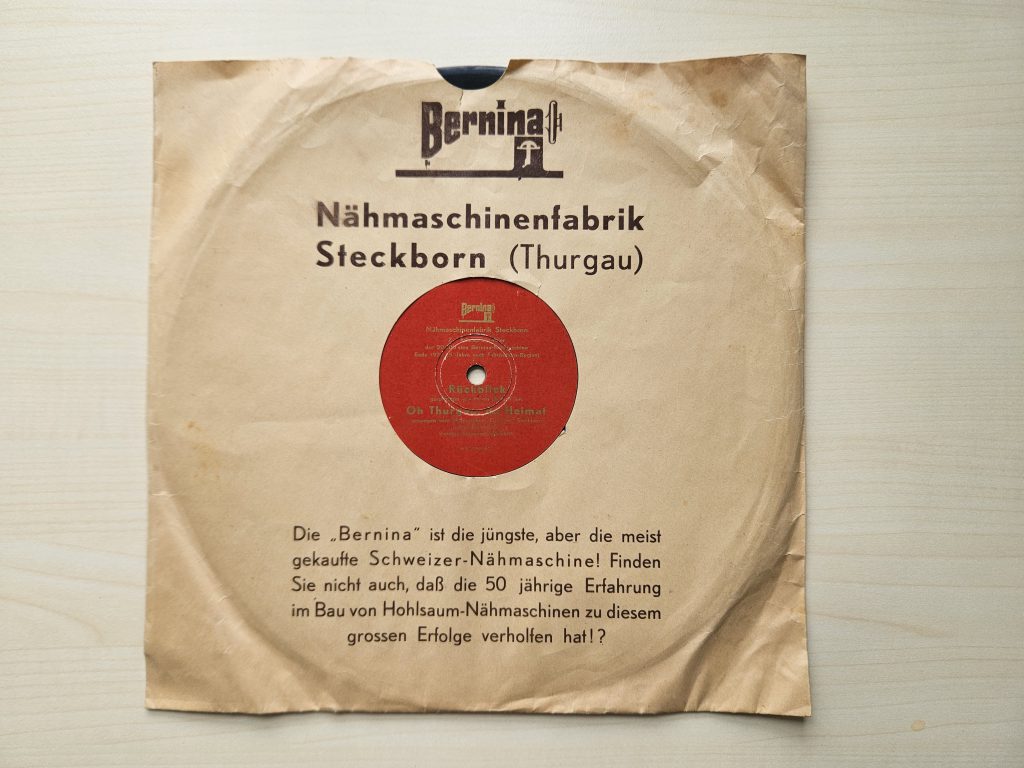
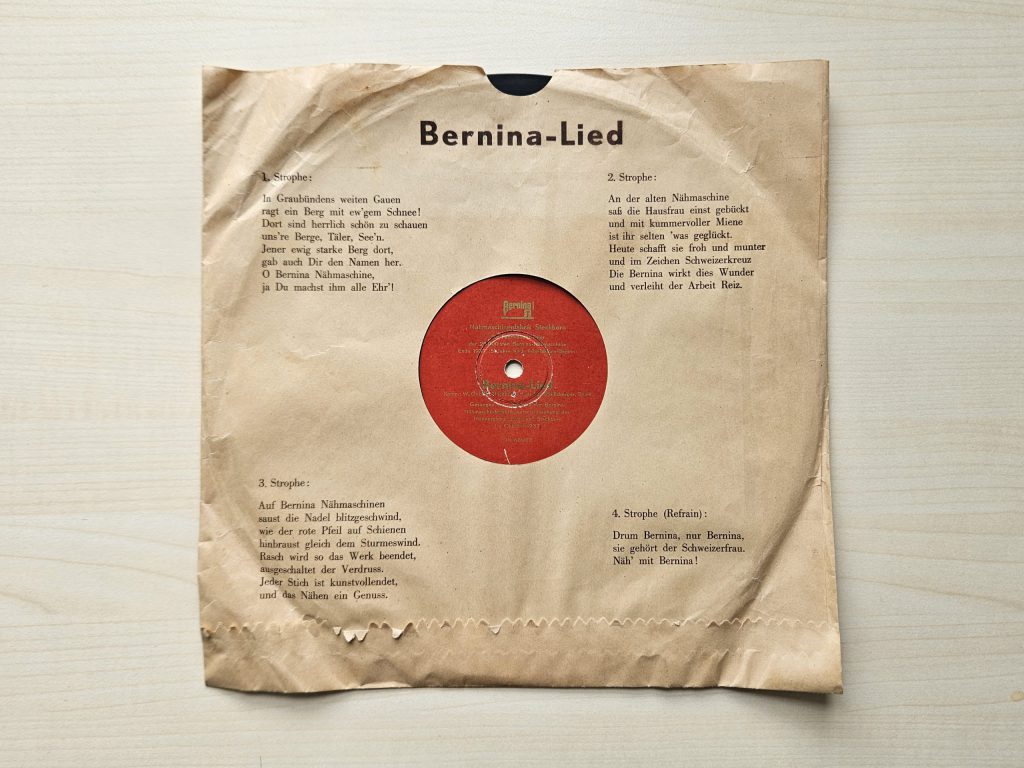
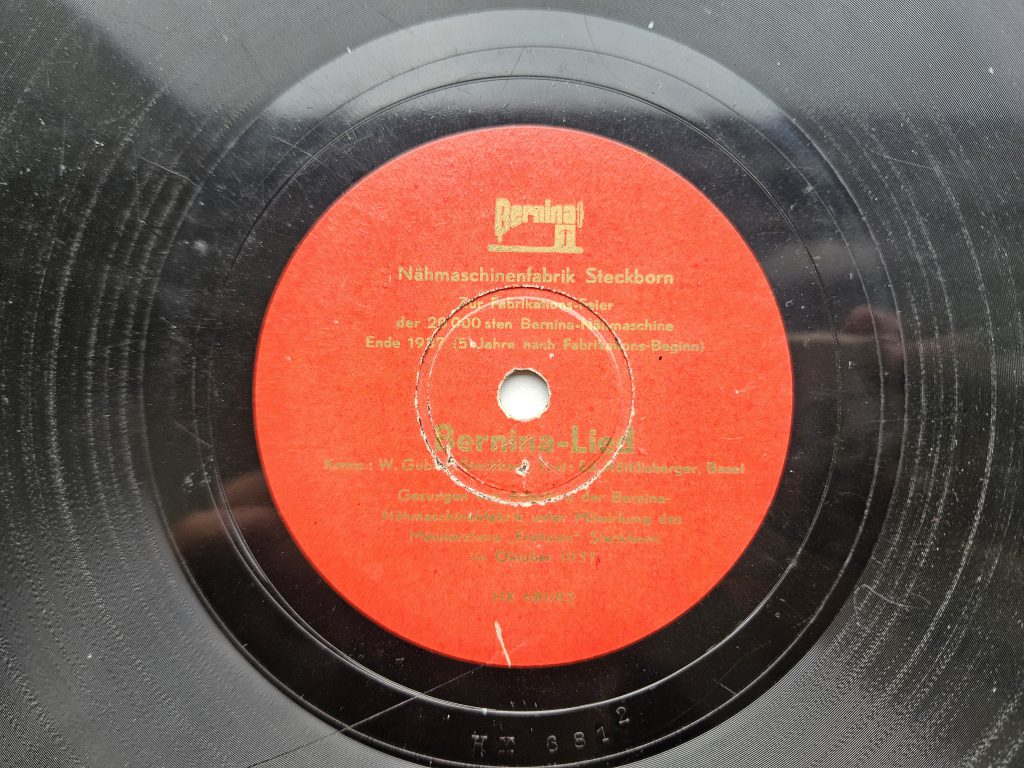
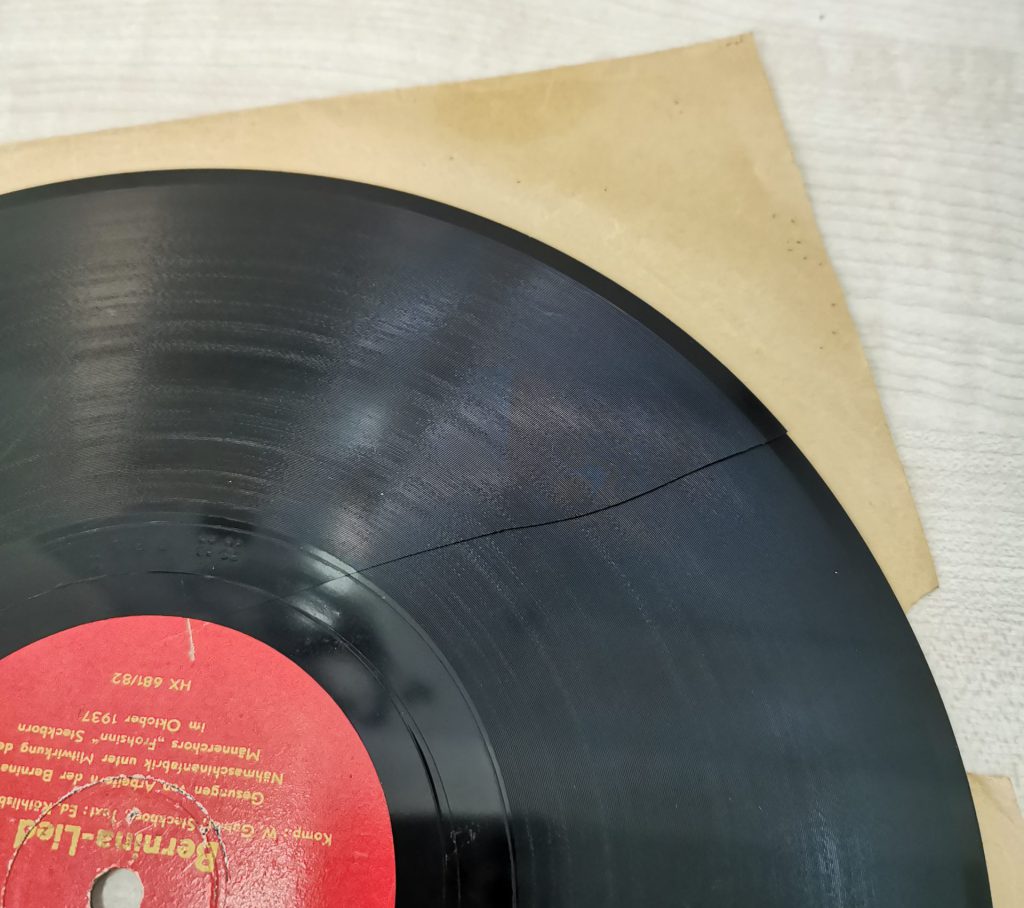


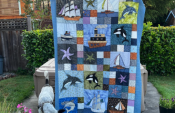

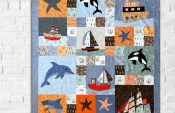

Was für ein herrliches Stück Firmengeschichte! Es hat bestimmt viele Spaß gemacht das alles herauszufinden. Vielen Dank für die Recherche, es bringt mich meiner Bernina Nähmaschine noch näher!
Hallo Claudia, herzlichen Dank für das positive Feedback. Das haben wir sehr gerne gemacht – die Recherche war auch für uns spannend. Hier übrigens der Artikel im deutschen Original: https://blog.bernina.com/de/2024/03/das-bernina-lied/
Lieber Gruss
Matthias
Loved this piece of history. Visited the Steckborn factory in 1990’s whilst living in Zurich. Witnessed the handtooling of parts and the feet.My first Bernina is an 801 model that my daughter uses, I have a 180 I take to classes and use a 770 QE at home.Can’t imagine owning any other brand. Would love to buy a lightweight machine with knee lever to replace my 180 when the screen dies.
Hi Flora, thank you very much for the feedback and for your loyalty to your brand. I hope your BERNINAs will continue to give you sewing pleasure for a long time to come. A lot has changed here in Steckborn since the 90’s – but it’s still a wonderful place to live and work. We feel privileged to work for this companny.
Kind regards
Matthias
I still remember the New Zealand bernina song and something sing it when using my machine.
Hi Anne, it really is a catchy tune! I just heard yesterday that there was a similarly popular song in a radio commercial in the Netherlands a long time ago. We’re trying to get a recording.
Kind regards
Matthias
I thoroughly enjoyed reading this post and listening to the recordings. My first Bernina was the 830 Record and I still use it today. However, my main go to machine is my 790+. Bernina quality is the best! Thanks for this look back in history.
Hi Donna, thank you very much for your kind feedback. I’m happy that you enjoyed this little journey through time.
Kind regards from Switzerland
Matthias